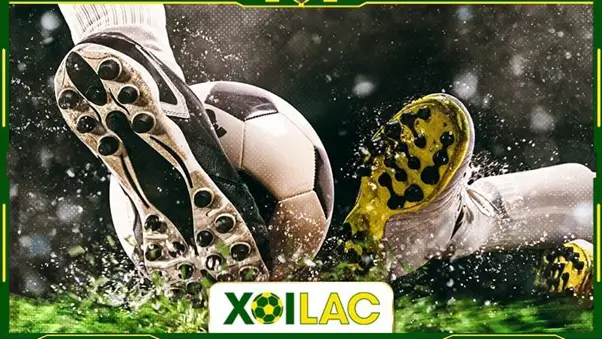Xoilac TV – Kênh xem trực tiếp bóng đá 90phut TTBD Full HD
Bạn là một trong những thành viên trong cộng đồng đam mê bóng đá và luôn tìm kiếm thông tin mới nhất về các giải đấu từ khắp nơi trên thế giới? Xoilac TV là lựa chọn lý tưởng dành cho bạn. Nơi cung cấp trải nghiệm xem bóng đá chất lượng cao hàng đầu tại Việt Nam. Hãy cùng khám phá thêm về kênh thông qua bài viết chi tiết sau.

1. Tổng hợp ý chính về Xoilac TV
Xoilac TV, thành lập từ năm 2018, là điểm đến không thể bỏ qua của những tín đồ bóng đá. Nơi cung cấp mọi thông tin cần thiết về làng bóng từ tin tức mới nhất, lịch thi đấu, kết quả, bảng xếp hạng, đến video highlights, phân tích chuyên sâu và dự đoán các trận đấu.
Được tạo ra với sứ mệnh phục vụ đam mê và tình yêu bóng đá của người hâm mộ. Kênh cam kết mang lại trải nghiệm xem bóng đá chất lượng cao. Nếu như bạn đang tìm kiếm một địa chỉ tin cậy để theo dõi và đắm chìm trong không khí sôi động của môn thể thao vua thì trực tiếp bóng đá Xoilactv chính là lựa chọn bạn không thể bỏ qua.
2. Tìm hiểu về nguồn gốc bắt nguồn của Xoilac TV
Xoilac TV trực tiếp từ khi ra đời đến nay đã nhanh chóng trở thành điểm đến yêu thích của người hâm mộ bóng đá. Với dịch vụ xem bóng đá trực tuyến miễn phí, không quảng cáo, cung cấp trải nghiệm xem mượt mà và chất lượng cao. Sức hút này của trang đến từ việc phủ sóng đa dạng các giải đấu từ khắp nơi trên thế giới. Cùng Đội ngũ biên tập viên và bình luận viên chuyên nghiệp, đam mê.
Vào năm 2020, trang web đã chính thức được đổi tên thành trực tiếp Xoilac TV, một sự lựa chọn tên gọi ý nghĩa phản ánh sự gần gũi và quen thuộc. Đó cũng chính là mong muốn của Xoilac tv 90 phút: mang đến cho người hâm mộ những trải nghiệm đỉnh cao của bóng đá. Từ những bàn thắng nghệ sĩ, những pha xử lý kỹ thuật. Đến những khoảnh khắc căng thẳng, hồi hộp và đầy cảm xúc của môn thể thao vua.
Đến năm 2021, trực tiếp bóng đá Xoilac 7 không chỉ giữ vững vị thế là trang web xem bóng đá hàng đầu mà còn mở rộng sứ mệnh của mình. Trở thành một trang thông tin thể thao toàn diện, cập nhật liên tục tin tức bóng đá trong nước và quốc tế.
Hơn thế nữa, trang đã mở rộng phạm vi phủ sóng, gồm các môn thể thao khác như quần vợt, bóng chuyền, cầu lông, bóng rổ, đua xe, võ thuật, mang đến một thế giới thể thao đa dạng và phong phú cho người xem.
3. Xoilac TV và những thế mạnh

3.1 Giao diện trang chủ Xoilac TV thân thiện, dễ sử dụng
Trang chủ của Xoilac1 mang đến một trải nghiệm người dùng ấn tượng với thiết kế đơn giản, trực quan và thân thiện. Người dùng có thể dễ dàng điều hướng và khám phá đa dạng nội dung từ tin tức mới nhất, lịch thi đấu, kết quả, bảng xếp hạng, video highlights, đến các bài phân tích sâu sắc, nhận định chuyên môn, và cả việc theo dõi các trận đấu trực tiếp.
Dù bạn quan tâm đến bóng đá trong nước, quốc tế, hay muốn mở rộng tầm nhìn với các môn thể thao khác, mọi thứ đều sẵn sàng và dễ tìm. Giao diện của Xoilac TV 90 được tối ưu hoá để đảm bảo trải nghiệm xem mượt mà trên mọi thiết bị, từ máy tính, laptop cho đến điện thoại di động, máy tính bảng và thậm chí là smart TV. Giúp bạn kết nối với niềm đam mê bóng đá mọi lúc, mọi nơi.
3.2 Cập nhật tin tức nhanh chóng
Xoilac TV trực tiếp không ngừng cập nhật những tin tức nóng hổi nhất về bóng đá và đa dạng các môn thể thao khác. Từ các sự kiện quy mô lớn như World Cup, Euro, Champions League, Olympic cho đến các giải đấu quốc gia, vùng lãnh thổ và giải đấu dành cho các tài năng trẻ.
Tại đây, bạn sẽ không bỏ lỡ bất kỳ thông tin quan trọng nào. Từ những diễn biến về chuyển nhượng, chấn thương, treo giò cho đến những tuyên bố của cầu thủ, huấn luyện viên và các quan chức bóng đá.
Ngoài ra, bạn cũng sẽ được đắm chìm trong những bài viết chất lượng, sâu sắc và trung thực. Đưa ra cái nhìn khách quan về các vấn đề nóng hổi, tranh luận sôi nổi, phân tích chi tiết và dự đoán các trận đấu sắp diễn ra.
3.3 Không quảng cáo làm phiền khi xem bóng đá
Xoilac 17 là một trong những trang web thể thao hiếm hoi không chứa bất kỳ quảng cáo nào. Điều này đồng nghĩa rằng bạn không phải lo lắng về những quảng cáo phiền phức làm giảm trải nghiệm của bạn. Gây khó chịu hay ảnh hưởng đến tốc độ truy cập, thậm chí đe dọa an toàn của thiết bị của bạn. Tận hưởng những trận đấu mượt mà, chất lượng và không bị gián đoạn bởi bất kỳ yếu tố nào, Xoilac7 TV cam kết mang đến cho bạn trải nghiệm xem bóng đá tốt nhất.
3.4 Đội ngũ BLV chuyên nghiệp
Xoilac TV tự hào sở hữu một đội ngũ bình luận viên chuyên nghiệp, giàu kinh nghiệm và đam mê bóng đá. Tại đây, bạn sẽ được chìm đắm trong những bình luận sôi nổi, hấp dẫn và chân thực từ những cái tên nổi tiếng như Quang Huy, Quang Tùng, Thành Luân, Duy Mạnh và Đình Thanh.
Họ sẽ mang đến cho bạn không chỉ những góc nhìn sâu sắc về trận đấu mà còn chia sẻ những cảm xúc, suy nghĩ và nhận định từ người hiểu biết và say mê bóng đá. Được hòa mình vào không khí sôi động của sân cỏ. Bạn sẽ cảm nhận được sức hút của bóng đá và kết nối với hàng triệu người hâm mộ khác trên khắp thế giới.
4. So sánh tính năng của các kênh bóng đá trực tuyến hiện nay

Dưới đây là một bảng so sánh chi tiết về các tính năng của các kênh bóng đá trực tuyến hiện nay: Xoilac TV, FPT Play, VTV6 và K+:
|
Tính năng |
Xoilac TV |
FPT Play |
VTV6 |
K+ |
|
Phí |
Miễn phí |
Có phí (đăng ký theo gói) |
Có phí (đăng ký truyền hình cáp) |
Có phí (đăng ký truyền hình cáp) |
|
Quảng cáo |
Không quảng cáo |
Có quảng cáo |
Có quảng cáo |
Có quảng cáo |
|
Độ phủ sóng |
Toàn cầu |
Toàn quốc |
Toàn quốc |
Toàn quốc |
|
Đa dạng nội dung |
Bóng đá quốc tế và trong nước, thể thao khác |
Bóng đá, phim, giải trí |
Bóng đá, giải trí |
Bóng đá, giải trí |
|
Chất lượng phát sóng |
Full HD |
HD tùy kết nối |
HD tùy kết nối |
HD/4K tùy kết nối |
|
Trải nghiệm |
Không gián đoạn, không quảng cáo |
Có gián đoạn, có quảng cáo |
Có gián đoạn, có quảng cáo |
Có gián đoạn, có quảng cáo |
|
Đội ngũ bình luận viên |
Chuyên nghiệp, đam mê bóng đá |
Chuyên nghiệp, đa dạng ngôn ngữ |
Chuyên nghiệp |
Chuyên nghiệp, đa dạng ngôn ngữ |
|
Tương thích |
Mọi thiết bị (máy tính, điện thoại, smart TV) |
Mọi thiết bị (máy tính, điện thoại, smart TV) |
Mọi thiết bị (máy tính, điện thoại, smart TV) |
Mọi thiết bị (máy tính, điện thoại, smart TV) |
5. Kết luận
Những thông tin chi tiết trong bài viết trên về kênh Xoilac TV đã mang đến cho bạn những kiến thức có ích. Hy vọng rằng, bạn sẽ có những giây phút tận hưởng tuyệt vời cùng chúng tôi!
